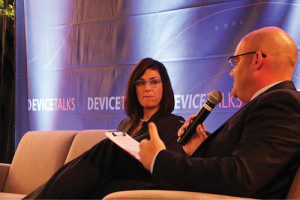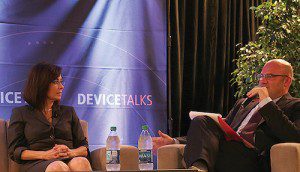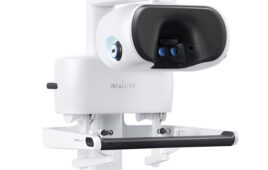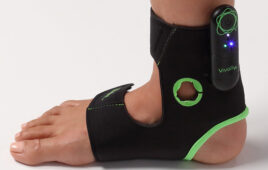Marie Johnson never had any intention of becoming the CEO of a medical device company with a mission of “changing the world,” but then again she never had any intention of becoming a widow with two small children, either.
Johnson, the founder and CEO of Northfield, Minn.-based Aum Cardiovascular, was a PhD student in 2002 when her 41-year-old husband died after suffering a sudden heart attack caused by a ruptured plaque in his left anterior descending vessel – also known as “the widowmaker.” The loss devastated Johnson and left her searching for answers to how a man in seeming perfect health could be struck down in the prime of his life.
By diving into her work, she found not only answers, but a mission to turn her tragedy into a discovery she says could change the world.
Aum Cardiovascular has commercialized a non-invasive test designed called the CADence, which the company says can quickly detect significant coronary stenosis before it turns deadly. Aum hopes the device, which is currently on the market in Germany, will eliminate needless death due to coronary artery disease, saving the healthcare systems millions of dollars in the process.
The CADence is designed to identify obstructions in the coronary arteries by detecting acoustic signals  generated by the turbulence created as blood flows past the obstruction, according to the company. Aum’s name is based on a Sanskrit syllable meaning “to make a continuous low humming sound,” akin to the information the CADence device is designed to extract from diseased coronary arteries.
generated by the turbulence created as blood flows past the obstruction, according to the company. Aum’s name is based on a Sanskrit syllable meaning “to make a continuous low humming sound,” akin to the information the CADence device is designed to extract from diseased coronary arteries.
Aum recently raised $5 million of a hoped-for $6.3 million funding round it plans to use to support its commercial growth overseas and its an ongoing U.S. pivotal trial.
The following is a transcript of a conversation, edited for clarity, between Marie Johnson and Medical Design & Outsourcing’s publisher Brian Johnson (no relation), recorded at the DeviceTalks Minnesota event held by our sister publication, MassDevice.com, in September 2015.
Brian Johnson: You’re an accidental entrepreneur. Thirteen years ago you were the mother of 2 very young children, you were working at 3M on a computerized stethoscope at the time. What were your ambitions then? Was being the CEO of a medical device company anywhere on your bucket list?
Marie Johnson: Thirteen years ago, I was working on my PhD, which was to develop a computerized stethoscope. I’m an engineer, and not an MD, so I needed to learn how to use a stethoscope. I collected data from my husband, who was 6 foot 1, about 180 pounds, 41 years old at the time, looked absolutely normal, swam 3 days a week. I collected data from him, learning how to auscultate. Nine months after I started my project, he died from a sudden cardiac event. My daughter was 4, she’s 17 now, my son was 7 weeks old at the time. At that point, I knew that I was going to do something to stop this terrible disease and sudden cardiac arrest.
Brian Johnson: Your husband was, for all intents and purposes, a very healthy man. As you said, you used him as a test case for your stethoscope. When you were doing it, you saw his heartbeat as a healthy heartbeat. Did either of you have any clue about coronary artery blockage? Did you know anything about sudden heart attack? What was your knowledge about the condition?
Marie Johnson: I think all of us know someone who’s had a heart attack, right? One in three Americans suffer from heart disease. I think, just like everybody in this audience, maybe the people here actually more so because you’re in med-tech, have heard about this. It’s just that experiencing one personally made it so much more real.
Brian Johnson: You had your husband actually go to a cardiologist, right?
Marie Johnson: I did. When I was pregnant with my son, I started having premonitions that he was going to die. I talked to our general practitioner, during a well baby visit, about these premonitions. I asked her if she would prescribe a treadmill stress test, which she did, and it came back normal. Actually, the technician said that he was kind of a star patient. He had the treadmill stress test, was absolutely normal.
Brian Johnson: It turned out that his heart was far more damaged than anyone anticipated, right?
Marie Johnson: After my husband died, I had to make the decision on whether or not I was going to get a job or finish my PhD. I decided I was just going to suck it up and finish my PhD.
After a period of about 3 months of grieving, I went in to meet with my faculty advisor, he was a cardiologist working in the echo lab. I know that he was expecting this, but we talked about the project and how to get reengaged. I pulled out the autopsy report, and I said, “Tell me what happened.”
He took his hand and looked down and explained to me that he had died from a vulnerable plaque that ruptured in his LAD, his widowmaker artery, and had severe blockage, 90 to 99% in the rest of his major coronary vessels. At the end of this discussion, with his hand like this [puts head in hands], I asked him, “If you had known that it was there, could you have done anything to fix it?”
He said, “Yes.” I knew right then that the work I was doing on my stethoscope, the data I had collected from my husband, and the alignment of having all of this information together, was by the hand of God, that I was supposed to do something about it.
Brian Johnson: Thinking back to that moment where the doctor puts his head on his hands, I’m thinking about what that must feel like for the family. You must have talked to hundreds of people who have experienced the same feeling that you’ve felt. Emotionally, you’ve already been kicked as hard as you could get, but then when you find out you could have prevented that, is that insult to injury?
Marie Johnson: Sure. You think it’s really unfair. It shouldn’t be that way. Your life is turned upside down. I don’t know a single widow or widower who would look at it and say, “Yeah, I expected something like this to happen to me.” It’s a complete shock.
Brian Johnson: It was at that moment where you, in your sleepless nights, started digging into the data looking for this sign of a sudden heart attack, right? This sound? Did you know what sound you were looking for at that time?
Marie Johnson: Absolutely not. The field of data mining was pretty new then. I changed my minor in my PhD program to statistics and started to employ a variety of statistical techniques – vectorization, matrix algebra, things that probably a lot of you had heard before, ARMA methods. I twisted and turned at this data, every way that I could. I remember the night where I found the signature, the frequency signature associated with coronary disease. The house was dark, the kids were in bed, I had my computer screen on, I was working. I did a frequency plot and I saw the frequencies in 50 to 100 Hertz region, and I heard a voice that said, “There it is.”
I knew I had it then, at least a portion of it. Then, what I did was I dug into the clinical literature, because I’m a scientist. I discovered that in 1967 a guy named Dock, D-O-C-K, he had a case study where he described a guy, 49-year-old guy, who had a moderate to severe stenosis in his widowmaker artery and consequent, moderate to severe murmur found at his second-left and third-left intercostal space on the peristernal border. I knew that we had it. From there, I always say that I found it by accident but it’s always been there.
Brian Johnson: At that moment are you saying, “I’m going to build a company?” Or are you saying, “I found this algorithm or I found this something, I’m just going to sell it to a company or I’m going to give it to somebody.” You have that answer that you were looking for, now what happens?
Marie Johnson: I discovered this frequency and a way to process it and disclosed it to the University of Minnesota, where I was doing a post-doctorate. The tech transfer office has a website and they put all their mentions on it, they look for entrepreneurs to take the device forward and build companies. They patented it, put it out on the website and nobody could see the vision, because it was math. It sat there for a few years and I did a post-doc out at Stanford with the folks at Bio-Design. I thought, “They’re not doing anything, I’m going to ask them to give me the patents back.”
They gave it back. I said, “Well, I have it, better do something now.” I didn’t do much for a long time, a few years. The Obama administration put out a call for grants in July of, I think, 2010. It was a very simple application. I filled it out and within about 3 months, the government gave us $250,000. I was working, I was leading a think tank at the university and I thought, “Well, the only way to spend this money responsibly is to leave the university.”
My turning point was for this grant, I had to set up this business account, so we had an LLC for a long time. Which, probably most of you know, is really nice, it’s a pass-through entity. I went to the bank and I met with a small business banker and we set up this account and the guy said to me, “Do you want a credit card and checks?” I said, “Why would I need a credit card and checks?” I got the credit card and the checks in the mail and all of a sudden it was a real business to me.
Brian Johnson: Even when you were starting this, you don’t think it’s a business?

Acoustical detection with CADence provides a completely new method for detecting significant coronary stenosis.
Marie Johnson: No.
Brian Johnson: Again, what’s pushing you at this moment? You just couldn’t stand to see that technology sitting there doing nothing?
Marie Johnson: Yeah. I think, at that point, it still wasn’t deliberate, to be honest with you. I had this chunk of money, I sort of had a vision about how we should spend it. I knew I wanted to get this product on the market. We just started moving forward. Of course, I live and breathe this mission, this is everything to me and I think it’s the purpose and meaning of my life at this point. If I die with this product on the market, I’ll die having done something.
Brian Johnson: You do, in fact, have it on the market in Germany.
Marie Johnson: We do, we are selling.
Brian Johnson: Here you are, you’re an accidental entrepreneur and you’re raising money now. Did you go out and raise money through venture capitalists?
Marie Johnson: No, no way. When I was on at Stanford, they always suggested the venture capital model; you developed the pitch stack, and you go in to reimbursement, regulatory. [St. Jude Medical founder and serial entrepreneur] Manny Villafana said to me, “You know, you can just use a PPM.” He gave me his PPM from Spain and said, “Read it.”
I looked it over, for those of you who don’t know, that’s a private placement memo and it’s a way to raise money from private individuals. Unbelievably, I have some incredible, high-net-worth individuals who have financed me to this point. I’ve raised about $10.3 million using that method. I’ve had a lot of people say, “Wow, you’ve gotten really far on that amount of money.” You can really ask anybody on my staff about spending money, they fill out purchase orders and they throw them on my desk and run away, nervous about my signing it. That’s the honest-to-God truth, you can ask any of them.
Brian Johnson: What have investors told you make them write the check? Is it the impact they see they could have or are they just drawn to this, a mission in the story?
Marie Johnson: I think that, for the first month, any of the people that are on my team, they’re still pretty enamored with the story. Then the reality of what we’re trying to do hits them. It’s a lot of hard work. The same thing happens with the high-net-worth individuals. They don’t give you money because they’re in love with a story. They fund this company and this mission because one-third of all Americans suffer from heart disease; we all know somebody that’s had a heart attack, someone that’s died from it or lives with it currently; their friends suffer from this. They see that we can detect obstructive coronary disease in about 20 minutes, and that’s taking the data to receiving the report back. We do it quickly, we do it non-invasively, and it’s actually a relaxing test. It takes only 8 minutes for us to collect the data, the patient’s lying on their back in supine position. No pharmaceuticals. It’s a no-brainer.
Brian Johnson: I think back when Tim Russert passed away from his sudden heart attack, and one of the things that the newspapers wrote was that it was a reminder that a visit to the doctor is not a bullet-proof vest and that even in the best of cardiology, there’s still this level of medicine that’s a guess. I wonder if that, as a scientist, that must still seem very shallow, that we’re still at the point of a guess.
Marie Johnson: I’m an engineer by training. This always surprises me, that the treadmill stress test, which is really the first test they will prescribe to determine if you have heart disease, is only 67% sensitive, which means that 33% of the time, they miss disease in a patient who’s sick.
On the other side of it, it has a sensitivity of about 72%, which means 28% of the time they tell a normal person that they’re diseased. You said, “Okay, that’s a treadmill, maybe it’s not so accurate.” An echo-cardiogram, a stress echo, which is a myocardial perfusion test, it’s 80-80. There really are no perfect tests for assessing heart condition.
Brian Johnson: The cardiologists that you’re working with, do they believe in what you’re doing when you’re talking to them for the first time, or do you find that there’s resistance, at all, to your device?
Marie Johnson: They usually say it’s too good to be true. Our FDA pivotal study is a non-inferiority study against nuclear stress tests. Nuclear stress test’s a $5,000 study, it’s a three- to five-hour test. We’re saying we’re not inferior to them. They want to see the data and that is our challenge, are the data.
We have a 1,000-patient pivotal study, we’re 957 patients into it, we’re a hair away from finishing that study. That’s a lot of data, but they want even more data, so we have another 1,000-patient post-market study going on in Europe. We have a 100-patient study, scientific-based study, going on here in St. Paul, but then also in Washington, D.C., so we’re all about the clinical proof. We want to show people that it works, because it does seem unbelievable.
Brian Johnson: It’s a $5,000 test? How much does the CADence test cost?
Marie Johnson: CADence is $100.
Brian Johnson: That’s a pretty dramatic savings right there.


![A photo of the Medtronic GI Genius ColonPro polyp detection system flagging a potential sign of colon cancer during a colonoscopy. [Photo courtesy of Medtronic]](https://www.medicaldesignandoutsourcing.com/wp-content/uploads/2024/04/Medtronic-GI-Genius-doctors-268x170.jpg)

